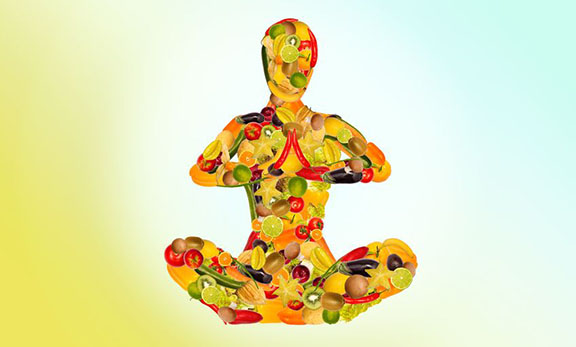 To fully understand Swami Satchidananda’s teachings on the relationship between Yoga and diet, specifically, the psychological and spiritual benefits of a vegetarian/vegan diet, it’s important to know something about the three gunas, or the qualities of nature. The philosophy behind the concept of the gunas is set forth in Book I, sutra 16, of Patanjali’s Yoga Sutras: Tat Param Purusa Khyater Gunavaitrsnyam. In English, “When there is non-thirst for even the gunas (constituents of nature) due to realization of the Purusha (true Self), that is supreme non-attachment”.
To fully understand Swami Satchidananda’s teachings on the relationship between Yoga and diet, specifically, the psychological and spiritual benefits of a vegetarian/vegan diet, it’s important to know something about the three gunas, or the qualities of nature. The philosophy behind the concept of the gunas is set forth in Book I, sutra 16, of Patanjali’s Yoga Sutras: Tat Param Purusa Khyater Gunavaitrsnyam. In English, “When there is non-thirst for even the gunas (constituents of nature) due to realization of the Purusha (true Self), that is supreme non-attachment”.
In his commentary on the Yoga Sutras, Swami Satchidananda wrote that, originally, the world, or Prakriti in Sanskrit, was avyakta, unmanifested. When Prakriti began to manifest, the ego came first; then, individuality emerged; and, finally, the mind materialized. From the mind, the tanmatras (a term that signifies the essence of objects) appeared, followed by the gross elements. This, from the yogic standpoint, is our natural evolution.
Yoga says that God is pure consciousness and Prakriti, the world, is there, too, its nature being to evolve and then to dissolve. Prakriti, in its unmanifested state, has both matter and force. When nature is in an unmanifested condition, the force is static or dormant. This force, or prana, has three components called the gunas: rajas, tamas, and sattva, or the active state, the passive state, and the tranquil state, respectively. When all three of these qualities are in equilibrium, they don’t affect matter. But even a little disturbance in the gunas creates motion in matter, giving rise to all the various forms; and that is how the entire universe, with all its elements, appears.
We can observe the gunas at work—and at play—in our personalities and even in the food that we eat. That is to say, some people are very active, even restless; others are slow and sluggish; and there are those who are tranquil and composed. In fact, in one of the principal scriptures of Yoga, the Bhagavad Gita, Lord Krishna offers a lengthy discourse on the various temperaments and the types of foods that attract them. First, he describes calm people and their preferred diet: Those of tranquil temperament [sattvic] prefer foods that increase vitality, longevity and strength; foods that enhance physical health and make the mind pure and cheerful; foods with substance and natural flavor; foods that are fresh, with natural oils and agreeable to the body (17:8).
In his commentary on the Bhagavad Gita, Swami Satchidananda explains that Lord Krishna describes for us the nature of sattvic foods: they enhance vitality, vigor, energy, good health, and joyfulness; they are tasty and fresh, with a little oil (sesame and sunflower seeds, for example), and easy to digest. Then, Krishna talks about restless people and their favorite foods: Those of a restless, compulsive temperament [rajasic] prefer foods that are very spicy or very sour, piping hot, bitter, dry, or quite salty. Such foods give rise to discomfort, pain and disease and, therefore, dismay (17:9).
Referring to Lord Krishna’s comments about the deleterious effects of rajasic foods, Swami Satchidananda stressed that it isn’t necessary to eat extremely spicy, hot food. He reminded us that just because Yoga comes from India, it doesn’t mean that if we practice Yoga, we need to copy everything that’s done in India. As a matter of fact, he said, eating hot food even once in awhile isn’t that good for us, because as much as a day or two after eating very spicy food, we may feel our entire alimentary canal burning. And from a more subtle perspective, Yoga teaches that if we’re practicing meditation, it’s better to refrain from eating spicy foods because these foods agitate the mind, making it difficult for us to meditate.
There has been a lot of discussion about the elimination of onions and garlic in a yogic diet. Swami Satchidananda was not opposed to them, in moderation, and not mainly added for purposes of taste. Rather, he often recommended their inclusion during the flu season. Onions and garlic do have some beneficial antiviral and antibiotic properties. They also can be helpful to control blood pressure and curb high cholesterol. Swami Satchidananda often recommended rasam (a South Indian soup made with lentils, water, tomato, black pepper and other spices, and tamarind pulp) that is very good for when one has a cold, as black pepper can help to control cold symptoms. He also said that for stomach problems South Indian mothers added more turmeric to their dishes, because turmeric is a good antiseptic. To treat inflammations, they add something sour. We can use food, he said, as medicine; but medicine should be taken only as needed, not just because the tongue likes it.
Certain yogis believe onions and garlic are just too exciting to the senses—particularly for those who wish to practice celibacy—and therefore do not add value to their diets. Some substitute ginger, turmeric, and asafetida (or “hing” powder), which is a digestive aid and has numerous medicinal properties plus adds a delicious flavor to foods.
Lastly, Krishna describes the lethargic types and their culinary preferences: Those of a dull and lazy temperament [tamasic] choose foods that are stale and tasteless, overcooked or left overnight, spoiled, rotting or even putrid. Such foods have lost their vitality and nutrition (17:10). Generally, foods that are old, overcooked, very cold, or moldy fall into the tamasic category.
Concerning the relationship between food and the mind, while certain personality types are attracted to particular kinds of food, conversely, these same foods directly affect the personality. For example, in the Bhagavad Gita, Lord Krishna tells us that rajasic food creates restlessness in the mind. Thus, if our goal is to keep our mind calm and to remain peaceful, we wouldn’t want to eat a lot of hot, spicy food or use too much garlic and onion. And, we wouldn’t eat meat, which makes us active in a restless, sometimes aggressive manner. Likewise, if we wish to remain alert and active, then we should stay away from those heavy, oily, overcooked, mind-numbing tamasic foods that make us dull and boring.
Swami Satchidananda taught that the manner in which we eat can also create a body and mind that is sattvic, rajasic, or tamasic. As an example, if we don’t chew sattvic food well, it will ferment in the body and may result in tamas, or lethargy. Also, if we overeat right before going to sleep, we will become tamasic.
So, if want to enjoy a balanced mind, a dynamic personality, a healthy body, and a peaceful and productive life, take the advice of the great yogis, past and present: make your diet a sattvic one. And always remember that diet shapes not only the body, but also the mind and the spirit.
About the Author:
 Reverend Sandra Kumari de Sachy, Ed.D. has been practicing Integral Yoga since 1980. She became a certified Integral Yoga teacher in 1981 and was ordained as an Integral Yoga minister in 1995. She has taught Hatha Yoga, Yoga philosophy, and meditation in colleges and universities, in Yoga centers and in prisons, and she continues to teach and serve at Satchidananda Ashram–Yogaville. Rev. Kumari has taught English in colleges and universities in the US and in France. She is the author of Bound to be Free: The Liberating Power of Prison Yoga, A Vision of Peace: The Interfaith Teachings of Sri Swami Satchidananda, and has published a number of articles on Yoga philosophy.
Reverend Sandra Kumari de Sachy, Ed.D. has been practicing Integral Yoga since 1980. She became a certified Integral Yoga teacher in 1981 and was ordained as an Integral Yoga minister in 1995. She has taught Hatha Yoga, Yoga philosophy, and meditation in colleges and universities, in Yoga centers and in prisons, and she continues to teach and serve at Satchidananda Ashram–Yogaville. Rev. Kumari has taught English in colleges and universities in the US and in France. She is the author of Bound to be Free: The Liberating Power of Prison Yoga, A Vision of Peace: The Interfaith Teachings of Sri Swami Satchidananda, and has published a number of articles on Yoga philosophy.
Source:The Yoga Way: Food for Body, Mind & Spirit By Swami Satchidananda; from the section on Yogic Diet by Reverend Sandra Kumari de Sachy, Ed.D.

